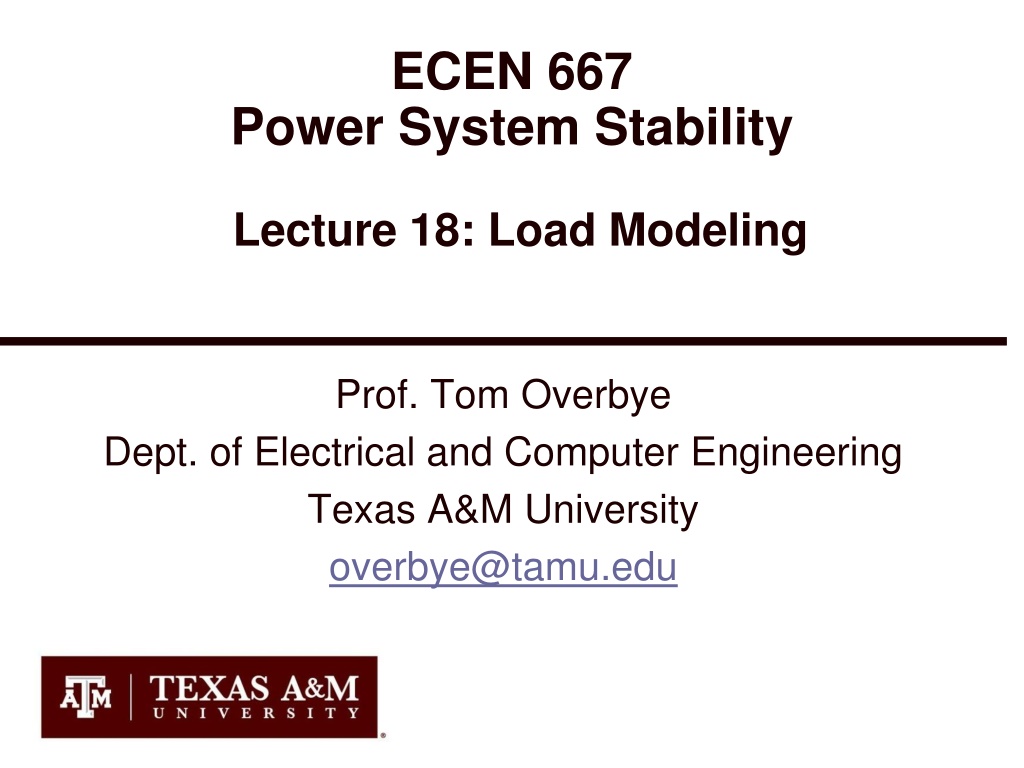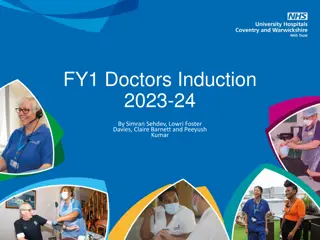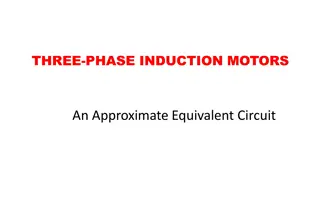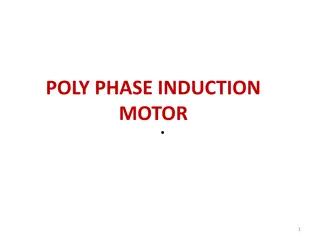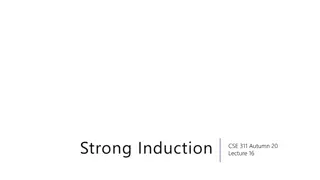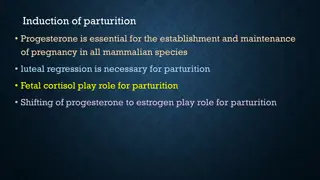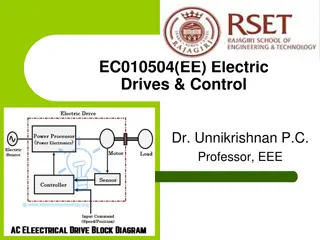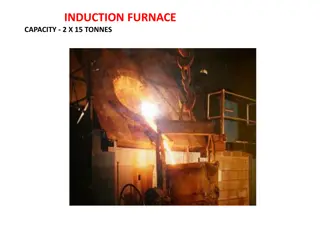Understanding Induction Motor Characteristics and Modeling in Power Systems
This content covers important aspects of induction motors in power systems, including load modeling, classes, stalling behavior, and impact on system stability. It discusses the major classes of induction motors based on applications, stalling phenomena due to voltage variations, and the significance of protective parameters in load models.
Download Presentation

Please find below an Image/Link to download the presentation.
The content on the website is provided AS IS for your information and personal use only. It may not be sold, licensed, or shared on other websites without obtaining consent from the author. Download presentation by click this link. If you encounter any issues during the download, it is possible that the publisher has removed the file from their server.
E N D
Presentation Transcript
ECEN 667 Power System Stability Lecture 18: Load Modeling Prof. Tom Overbye Dept. of Electrical and Computer Engineering Texas A&M University overbye@tamu.edu
Announcements Read Chapter 7 Homework 4 is due today Homework 5 is due on Thursday Nov 7 1
Induction Motor Classes Four major classes of induction motors, based on application. Key values are starting torque, pull-out torque, full-load torque, and starting current In steady-state the motor will operate on the right side of the curve at the point at which the electrical torque matches the mechanical torque A: Fans, pumps machine tools B: Similar to A, common with HVAC applications C: Compressors, conveyors D: High inertia such as hoists Class B machines should have a lower starting current compared to A (500% rated versus 800% for B) 2 2 Image source: ecmweb.com/motors/understanding-induction-motor-nameplate-information
Induction Motor Stalling Height of the torque-speed curve varies with the square of the terminal voltage When the terminal voltage decreases, such as during a fault, the mechanical torque can exceed the electrical torque This causes the motor to decelerate, perhaps quite quickly, with the rate proportional to its inertia This deceleration causing the slip to increase, perhaps causing the motor to stall with s=1, resulting in a high reactive current draw Too many stalled motors can prevent the voltage from recovering 3 3
Motor Stalling Example Using case WSCC_CIM5, which models the WSCC 9 bus case with 100% induction motor load Change the fault scenario to say a fault midway between buses 5 and 7, cleared by opening the line Results are for a 0.05 second fault 1.05 1 0.95 0.9 0.85 0.8 0.75 0.7 0.65 Usually motor load is much less than 100% 0.6 0.55 0.5 0.45 0.4 0.35 0 0.5 1 1.5 2 2.5 3 3.5 4 4.5 5 V pu_Bus Bus 2 V pu_Bus Bus 6 V pu_Bus Bus1 V pu_Bus Bus 3 V pu_Bus Bus 7 V pu_Bus Bus 4 V pu_Bus Bus 8 V pu_Bus Bus 5 V pu_Bus Bus 9 g f e d c b g f e d c b g f e d c b g f e d c b g f e d c b g f e d c b g f e d c b g f e d c b g f e d c b 4 4
Impact of Model Protection Parameters Some load models, such as the CIM5, have built- in protection system models. For CIM5 the Vi and Ti fields are used to disconnect the load when its voltage is less than Vi for Ti cycles When running simulations you need to check for such events 5 5
Motor Stalling With Longer Fault The below image shows the WECC_CIM5 system with the fault clearing extended to 0.12 seconds 1.1 The models are no longer giving realistic results; two generators trip on over speed; then the load trips after 4 seconds. 1 0.9 0.8 0.7 0.6 0.5 0.4 0.3 0.2 0.1 0 0.5 1 1.5 2 2.5 3 3.5 4 4.5 5 V pu_Bus Bus 2 V pu_Bus Bus 6 V pu_Bus Bus1 V pu_Bus Bus 3 V pu_Bus Bus 7 V pu_Bus Bus 4 V pu_Bus Bus 8 V pu_Bus Bus 5 V pu_Bus Bus 9 g f e d c b g f e d c b g f e d c b g f e d c b g f e d c b g f e d c b g f e d c b g f e d c b g f e d c b 6 6
Transient Limit Monitors There are different performance criteria that need to be met for a scenario Similar performance criteria exist for frequency deviations Image from WECC Planning and Operating Criteria 7 7
Motor Starting Motor starting analysis looks at the impacts of starting a motor or a series of motors (usually quite large motors) on the power grid Examples are new load or black start plans While not all transient stability motor load models allow the motor to start, some do When energized, the initial condition for the motor is slip of 1.0 Motor starting can generate very small time constants 8 8
Motor Starting Example Case WSCC_MotorStarting takes the previous WSCC case with 100% motor load, and considers starting the motor at bus 8 In the power flow the load at bus 8 is modeled as zero (open) with a CIM5 The contingency is closing the load Divided into four loads to stagger the start (we can't start it all at once) Since power flow load is zero, the CIM5 load must also specify the size of the motor This is done in the Tnom field and by setting an MVA base value 9 9
Motor Starting Example Below graph shows the bus voltages for starting the four motors three seconds apart Bus 8 1.08 Bus 7 Bus 9 Bus 3 Bus 2 0.833 pu 1.06 1.04 185 MW 53 Mvar 92 MW 27 Mvar 0.909 pu 0.882 pu 0.901 pu 0.917 pu 39 MW 23 Mvar 0 MW 0 Mvar 1.02 37 MW 92 Mvar 0 MW 0 Mvar 1 Bus 5 0.888 pu Bus 6 0.912 pu 0.98 0.96 118 42 Mvar MW 0.94 86 MW 25 Mvar Bus 4 0.949 pu 0.92 0.9 Bus1 1.003 pu 0.88 14 MW 94 Mvar 0.86 slack 0.84 0 2 4 6 8 10 12 14 16 18 20 V pu_Bus Bus1 V pu_Bus Bus 5 V pu_Bus Bus 9 V pu_Bus Bus 2 V pu_Bus Bus 6 V pu_Bus Bus 3 V pu_Bus Bus 7 V pu_Bus Bus 4 V pu_Bus Bus 8 g f e d c b g f e d c b g f e d c b g f e d c b g f e d c b g f e d c b g f e d c b g f e d c b g f e d c b 10 10
Motor Starting: Fast Dynamics One issue with the starting of induction motors is the need to model relatively fast initial electrical dynamics Below graph shows E'r for a motor at bus 8 as it is starting Load Bus 8 #1 States of Load\Epr 0.28 0.26 0.24 0.22 0.2 0.18 0.16 0.14 0.12 0.1 0.08 0.06 0.04 0.02 Time scale is from 1.0 to 1.1 seconds Load Bus 8 #1 States of Load\Epr 0 -0.02 -0.04 -0.06 -0.08 -0.1 1 1.005 1.01 1.015 1.02 1.025 1.03 1.035 1.04 1.045 1.05 1.055 1.06 1.065 1.07 1.075 1.08 1.085 1.09 1.095 1.1 Time Load Bus 8 #1 States of Load\Epr 11 11
Motor Starting: Fast Dynamics These fast dynamics can be seen to vary with slip in the ss term V E R I = + = + + = X I D D s D Q V E R I X I Q Q s Q D dE dt dE dt 1 T ( ) ( ) D + sE E X X I D s Q Q o Q 1 T ( ) ( ) D Q = sE E X X I s D o Simulating with the explicit method either requires a small overall t or the use of multi-rate methods 12 12
Multi-Rate Explicit Integration Key idea is to integrate some differential equations with a potentially much faster time step then others Faster variables are integrated with time step h, slower variable with time step H Slower variables assumed fixed or interpolated during the faster time step integration Figure from Jingjia Chen and M. L. Crow, "A Variable Partitioning Strategy for the Multirate Method in Power Systems," Power Systems, IEEE Transactions on, vol. 23, pp. 259-266, 2008. 13 13
Multi-Rate Explicit Integration First proposed by C. Gear in 1974 Power systems use by M Crow in 1994 In power systems usually applied to some exciters, stabilizers, and to induction motors when their slip is high Subinterval length can be customized for each model based on its parameters (in range of 4 to 128 times the regular time step) Tradeoff in computation C. Gear, Multirate Methods for Ordinary Differential Equations, Univ. Illinois at Urbana-Champaign, Tech. Rep., 1974. M. Crow and J. G. Chen, The multirate method for simulation of power system dynamics, IEEE Trans. Power Syst., vol. 9, no. 3, pp.1684 1690, Aug. 1994. 14 14
AC Motor Drives A historical shortcoming of ac motors was their lack of speed control when supplied by a fixed frequency ac With advances in power electronics it is now common to use an ac-ac converter to provide the machine with a varying and controllable ac frequency; this allows for variable speed operation Known as a variable frequency drives (VFDs) Variable speed operation can result in significant energy savings speed becomes on optimization parameter Commonly use V/Hz control to keep the flux constant 15
Need for Better Load Modeling: History of Load Modeling in WECC 1990 s Constant current real, constant impedance reactive models connected to a transmission bus IEEE Task Force recommends dynamic load modeling, however it does not get traction in the industry 1996 Model validation study for July 2 and August 10 system outages: Need for motor load modeling to represent oscillations and voltage decline 2000 s WECC Interim Load Model: 20% of load is represented with induction motors Tuned to match inter-area oscillations for August 10 1996 and August 4, 2000 oscillation events Source: certs.lbl.gov/sites/all/files/5-6-kosterev-undrill-load-modeling-in-wecc.pdf 16 16
Need for Better Load Modeling: History of Load Modeling in WECC What the simulations done using the interim load model indicated would occur Vertical scale goes down to about 0.6 per unit 17 17 Source: certs.lbl.gov/sites/all/files/5-6-kosterev-undrill-load-modeling-in-wecc.pdf
Need for Better Load Modeling: History of Load Modeling in WECC What was actually sometimes occurring, known as fault induced delayed voltage recovery (FIDVR) Seen in 1980 s; traced to stalling air-conditioning load 18 18
Single Phase Induction Motor Loads A new load model is one that explicitly represents the behavior of single phase induction motors, which are quite small and stall very quickly Single phase motors also start slower than an equivalent three phase machine New single phase induction motor model (LD1PAC) is a static model (with the assumption that the dynamics are fast), that algebraically transitions between running and stalled behavior based on the magnitude of the terminal voltage 19 19
